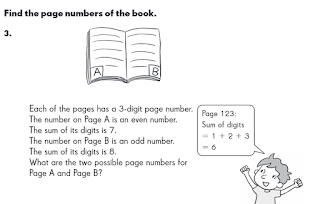 We have been working with a program called Code Monkey, which presents scaffolded coding challenges. Several of my students despair when they are not able to solve a problem right away. They ask certain peers for "help", by which they mean they want someone to tell them the answer.
We have been working with a program called Code Monkey, which presents scaffolded coding challenges. Several of my students despair when they are not able to solve a problem right away. They ask certain peers for "help", by which they mean they want someone to tell them the answer.In addition, the class worked on "Thinking Cap" problems yesterday. In our Math in Focus curriculum, these problems require the students to solve more complicated, depthful problems. Once again, many students were not able to maintain their efforts. They wanted help almost right away.
 |
| This is the Thinking Cap problem I am referencing |
In addition, I am questioning if I should add one more disposition to my current list of four. The students lack a sense of what might be called "purposeful tinkering". They try one or two things and then give up. In activities like Makerspace challenges, Code Monkey problems, or "Thinking Caps", students need to be able to try a number of approaches. They can then learn new information from each attempt. To me, trial and error means that you try something and learn from the error.
This could be defined as a disposition - the habit of playing around with a situation in differing ways. My colleague suggested calling this Experimentation, which seems good enough at this point. This type of thinking is critical to STEAM, although I just didn't think of it as a disposition until recently.
It also just occurred to me that the addition of Experimentation to my list allows me to make an acronym of my dispositions: Cooperation, Optimism, Visualization, Experimentation, Reflection (COVER).




